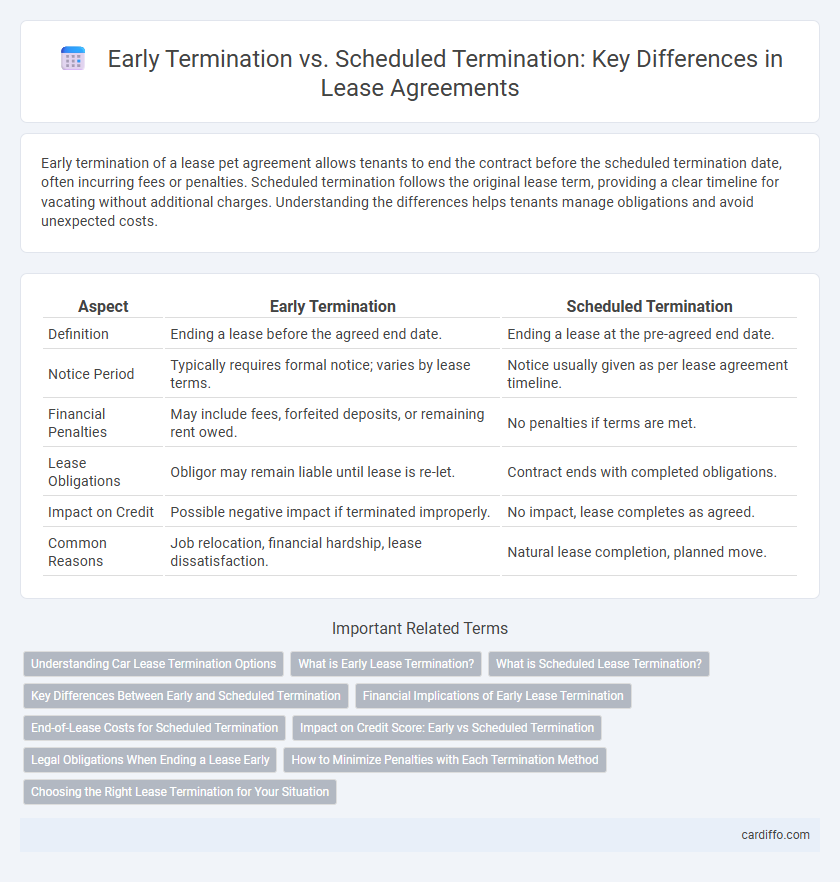Early termination of a lease pet agreement allows tenants to end the contract before the scheduled termination date, often incurring fees or penalties. Scheduled termination follows the original lease term, providing a clear timeline for vacating without additional charges. Understanding the differences helps tenants manage obligations and avoid unexpected costs.
Table of Comparison
| Aspect | Early Termination | Scheduled Termination |
|---|---|---|
| Definition | Ending a lease before the agreed end date. | Ending a lease at the pre-agreed end date. |
| Notice Period | Typically requires formal notice; varies by lease terms. | Notice usually given as per lease agreement timeline. |
| Financial Penalties | May include fees, forfeited deposits, or remaining rent owed. | No penalties if terms are met. |
| Lease Obligations | Obligor may remain liable until lease is re-let. | Contract ends with completed obligations. |
| Impact on Credit | Possible negative impact if terminated improperly. | No impact, lease completes as agreed. |
| Common Reasons | Job relocation, financial hardship, lease dissatisfaction. | Natural lease completion, planned move. |
Understanding Car Lease Termination Options
Early termination of a car lease involves ending the contract before the agreed-upon date, often incurring fees or penalties that can increase the overall cost. Scheduled termination occurs when the lease naturally expires, allowing the lessee to return the vehicle without extra charges and possibly purchase or lease a new car. Understanding the financial implications and lease terms is essential for choosing between early termination or waiting for the scheduled lease end to minimize expenses.
What is Early Lease Termination?
Early lease termination refers to the process where a tenant ends their lease agreement before the scheduled end date, typically involving specific penalties or fees outlined in the contract. This differs from scheduled termination, which occurs when the lease naturally expires without breach or additional costs. Understanding the terms and financial implications of early termination is crucial for tenants to avoid unexpected charges and legal complications.
What is Scheduled Lease Termination?
Scheduled lease termination refers to the predetermined end date of a lease agreement as specified in the contract, where both tenant and landlord agree that the lease will conclude without penalties. This type of termination ensures clear expectations for possession return and final payments, minimizing disputes and facilitating smooth transition for both parties. Unlike early termination, scheduled lease termination follows the original lease timeline, maintaining legal compliance and contractual obligations.
Key Differences Between Early and Scheduled Termination
Early termination involves ending a lease agreement before the agreed-upon expiration date, often incurring penalties or fees, while scheduled termination occurs when the lease naturally concludes at the end of its fixed term without additional charges. Key differences include the financial implications, with early termination typically requiring compensation for lost rent or contractual damages, whereas scheduled termination follows the original payment schedule. Legal obligations also vary, as early termination may demand written notice and landlord approval, contrasted with scheduled termination that fulfills all lease conditions by default.
Financial Implications of Early Lease Termination
Early lease termination often results in significant financial penalties, including loss of security deposits, early termination fees, and liability for remaining rent payments. Scheduled termination allows tenants to avoid these extra costs by adhering to the lease end date, supporting better budget management. Understanding the financial implications of early lease termination is crucial for both landlords and tenants to mitigate unexpected expenses.
End-of-Lease Costs for Scheduled Termination
Scheduled termination typically involves predefined lease-end costs such as disposition fees, lease-end inspection charges, and potential excess mileage or wear-and-tear penalties clearly outlined in the contract. These expenses are expected and budgeted for, allowing lessees to plan their finances accordingly. In contrast to early termination fees, end-of-lease costs for scheduled termination are usually lower and more predictable, reflecting the lease's natural conclusion.
Impact on Credit Score: Early vs Scheduled Termination
Early termination of a lease often results in a negative impact on credit scores due to potential missed payments, early termination fees, or collection accounts if obligations are not met promptly. Scheduled termination typically has no adverse effect on credit as the lease concludes according to the original contract terms, reflecting responsible financial behavior. Credit reporting agencies view early termination as a risk factor, potentially lowering creditworthiness, whereas scheduled termination demonstrates reliable repayment history.
Legal Obligations When Ending a Lease Early
Early termination of a lease typically requires tenants to fulfill specific legal obligations, such as providing advance written notice, paying early termination fees, or covering rent until a new tenant is found, depending on the lease agreement and local laws. Scheduled termination occurs at the end of the lease term with no penalties, provided all terms and conditions are met, including property condition and final payments. Understanding state and local landlord-tenant laws is crucial to avoid legal disputes and financial liabilities when ending a lease prematurely.
How to Minimize Penalties with Each Termination Method
Early termination penalties can be minimized by reviewing the lease agreement for clauses like early termination fees, notice periods, and subletting options, which may reduce financial liabilities. Scheduled termination typically avoids penalties when the lease ends on the agreed date, but confirming lease renewal or non-renewal terms in advance helps prevent unexpected charges. Negotiating with the landlord for lease buyouts or extensions offers flexibility to lower penalties regardless of the termination method chosen.
Choosing the Right Lease Termination for Your Situation
Early termination of a lease allows tenants to end their lease agreement before the scheduled expiration date, often incurring fees or penalties, whereas scheduled termination follows the lease's natural end without additional costs. Choosing the right lease termination depends on factors such as financial flexibility, future plans, and potential lease break penalties outlined in the contract. Evaluating whether the immediate need to vacate outweighs the cost of early termination or if waiting until the scheduled termination is more practical ensures optimal lease management.
Early Termination vs Scheduled Termination Infographic

 cardiffo.com
cardiffo.com